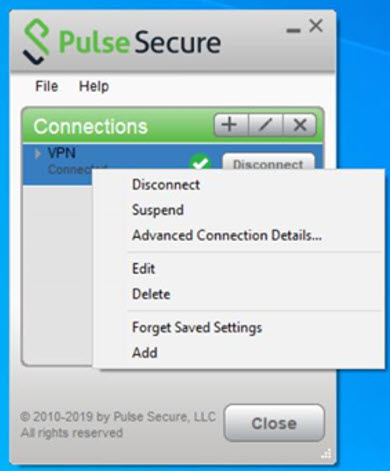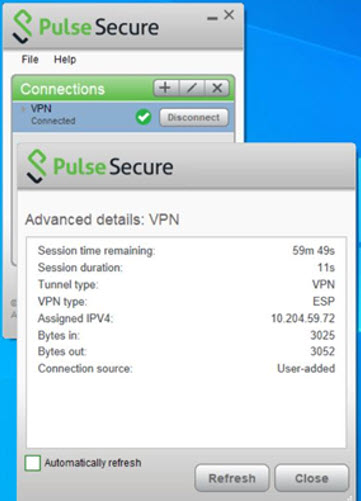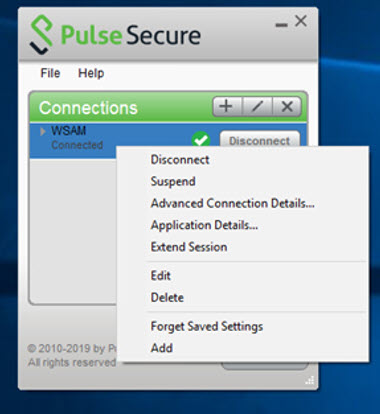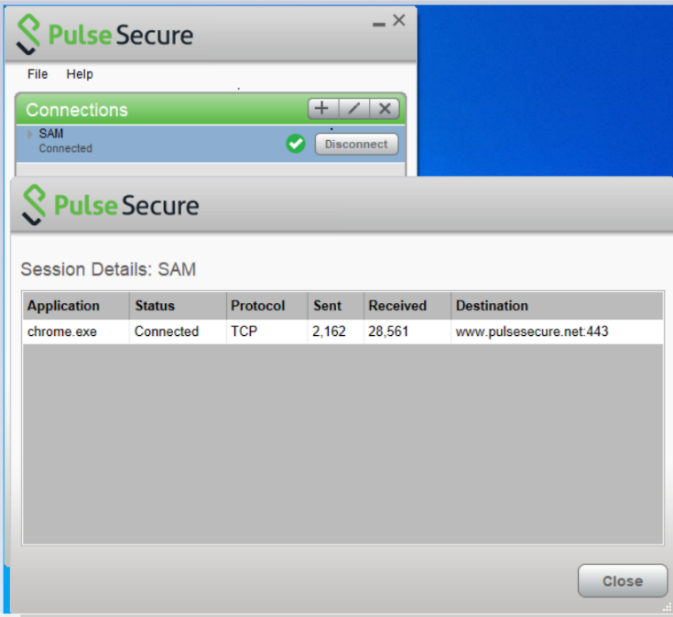Pulse Client for Windows
The Pulse Client for Windows user interface (see figure) lists the deployed Pulse Client connections. Each connection is a set of properties that enables network access through a specific Ivanti server. The user can expand a connection to see more details about the connection.
From 5.3R2, Pulse Client connects to PSA device through proxy at the first attempt and then try connecting directly upon failure.
VPN Connection Details
To view the VPN connection details dialog:
1.Select the VPN connection from the list of connection items.
2.Click File --> Connections --> Advanced Connection Details, or Right click the selected connection to get the context menu, refer to the following figure.

The Advanced Connection Detail information window will not update automatically. For example, the session time remaining shows how much time remains when you open the dialog. To update advanced detail information, click Refresh or click the check box labeled automatically refresh.

The Advanced Connection Details window gives the following information
|
Field Name |
Description |
|
Session time remaining |
The duration that the current VPN session will remain active before credentials must be re-entered or the session manually extended. |
|
Session Duration |
The duration elapsed for the session. |
|
Tunnel type |
This describes that the connection is a VPN tunnel. |
|
VPN type |
The protocol used to create the tunnel (SSL or ESP). |
|
Assigned IPv4 |
The IPv4 address assigned to the Pulse virtual adapter. |
|
Bytes in |
Number of bytes received through the tunnel. |
|
Bytes out |
Number of bytes sent through the tunnel. |
|
Connection Source |
This describes how the Pulse client received the connection entry: If the value is Preconfigured, then the connection entry came from a Connection Set that was downloaded from a gateway. And if the value is Dynamic, then it means that the connection entry was resulted from launching the Pulse client by connecting a web browser to an Ivanti gateway and pressing the "Start" button on the web page |
PSAM Connection Details
To view the PSAM Advanced Connection Details dialog:
1.Select the PSAM connection from the list of connection items.
2.Click File --> Connections --> Advanced Connection Details, or right click the selected connection to get the context menu, refer to the following figure.


The Advanced Connection Detail information will not update automatically. For example, the session time remaining shows how much time remains when you open the dialog. To update advanced detail information, click Refresh or click the check box labeled automatically refresh.
The Advanced Connection Details window gives the following information:
|
Field Name |
Description |
|
Session time remaining |
The duration that the current VPN session will remain active before credentials must be re-entered or the session manually extended. |
|
Session Duration |
The duration elapsed for the session. |
|
Tunnel type |
This describes that the connection is a port/application mapping through SAM (Secure Access Manager). |
|
VPN type |
The protocol used to create the tunnel (SSL or ESP). |
|
Bytes in |
Number of bytes received through the tunnel. |
|
Bytes out |
Number of bytes sent through the tunnel. |
PSAM Application Details
1.Select the PSAM connection from the list of connection items.
2.Click File --> Connections --> Application Details, or right click on the selected connection to get the context menu, refer to the following figure.

PSAM Session Details
To view the PSAM Session Details dialog:
1.Select the PSAM connection from the list of connection items.
2.Click File --> Connections --> SAM Session Details, or right click the selected connection to get the context menu, refer to the following figure.

The PSAM Session Details window gives the following information:
|
Field Name |
Description |
|
Application |
The name of the application running in the active session. |
|
Status |
The status of the application in the session. |
|
Protocol |
The protocol used for the session. |
|
Sent |
Number of bytes sent in the established session. |
|
Received |
Number of bytes received in the established session. |
|
Destination |
The target used by the application. |
Pulse Client also displays a system tray icon that provides connection status, and can allow the user to connect and disconnect and enables quick access to the program interface. One tray icon provides status for all active connections.
Typically, the network administrator defines and deploys the Pulse Client connections but you can also enable users to define, edit, and remove their own connections.
|
Indicator |
Description |
|
|
Connected. |
|
|
Connecting. |
|
|
Connected with limitations |
|
|
Connection attempt failed. |
|
|
Connection suspended. |
|
|
Connected to the local network but no Internet access available. Public WiFi locations often deploy a captive portal that requires the user to enter authentication information or to accept terms of service before network access is granted. Pulse Client detects the presence of captive portals and does not initiate a connection to a Ivanti server until Internet access is granted. |
Pulse Client supports the Federal Information Processing Standard (FIPS), which defines secure communication practices for the U.S. government. If FIPS is enabled on the endpoint, "FIPS On" appears near the bottom the Pulse Client window.
A single system tray icon indicates the status of all active Pulse Client connections. You can right-click the system tray icon to control Pulse Client connections, to open the Pulse Client interface, or to exit from Pulse Client. The following table shows the connection status indicated by the system tray icon.
|
Indicator |
Description |
|
|
No connection |
|
|
Connecting. A connection stays in this state until it fails or succeeds. |
|
|
Suspended |
|
|
Connected with issues |
|
|
Connection failed |
|
|
Connected |
|
|
Connected to the local network but no Internet access available. Public WiFi locations often deploy a captive portal that requires the user to enter authentication information or to accept terms of service before network access is granted. Pulse Client detects the presence of captive portals and does not initiate a connection to a Ivanti server until Internet access is granted. |